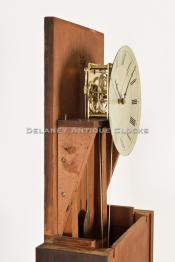Aaron Willard. Massachusetts Dish Dial Shelf Clock made in Boston, Massachusetts. VV-133.
Aaron Willard in Boston, Massachusetts, made this Massachusetts Dish Dial Shelf Clock.
This is the traditional case form. It is elevated up off the shelf by four brass ball feet. These are applied or secured to the bottom of the case and are original to this example. The base section features a pillow molding of mahogany that supports a half-round mahogany frame. This frame is fitted with a period mirror that exhibits wonderful texture. The case lot number, which is die stamped inside the lower frame, on the backboard of the case, and on the inside divider, is “140.” The bonnet or hood of the clock can be removed in the same manner as the tall case clock version. It slides forward. This version is surmounted with a nicely shaped fret pattern that centers a finial plinth and decorative brass finial. The bonnet door is framed in half-round moldings. This framing supports a reverse-painted glass tablet. The colors found here are excellent, and the detail work is outstanding. It is in this location that the Maker signs this type of clock along with his working location. This can be found below the dial inside the red-colored oval. Floral decorations surround this oval. The spandrel areas are decorated with musical harps. This door opens to access the iron dial, which is a convex form. The hands are skillfully made and feature arrow pointers.
The time-only movement is constructed in brass and designed to run for eight days on a full wind. It is a timepiece and is powered by a cast iron weight.
This clock was made circa 1820 and stands approximately 34.75 inches tall to the top of the finial. It is 13.25 inches wide and 5.75 inches deep.
Inventory number VV-133.
Aaron Willard was born in Grafton, Massachusetts, on October 13, 1757. Little is currently known of Aaron's early life in Grafton. His parents, Benjamin Willard (1716-1775) and Sarah (Brooks) Willard (1717-1775) of Grafton had eleven children. Aaron was one of four brothers that trained as a clockmaker. In Grafton, he first learned the skills of clock-making from his older brothers Benjamin and Simon. It is recorded that Aaron marched with them in response to the Lexington Alarm on April 19, 1775, as a private under Captain Aaron Kimball's Company of Colonel Artemus Ward's Regiment. Aaron re-enlisted on April 26 and was soon sent by General George Washington as a spy to Nova Scotia in November. By this time, he had reached the grade of Captain. He soon returned to Grafton to train as a clockmaker. In 1780, Aaron moved from Grafton to Washington Street in Roxbury along with his brother Simon. Here the two Willards establish a reputation for themselves as fine clock manufacturers. They were both responsible for training a large number of apprentices. Many of these became famous clockmakers in their own right. The Willards dominated the clock-making industry in the Boston area during the first half of the nineteenth century. Aaron worked in a separate location in Roxbury from his brother and, in 1792, relocated about a quarter-mile away from Simon's shop across the Boston line. Aaron is listed in the 1798 Boston directory as a clockmaker "on the Neck," His large shop employed up to 30 people, while 21 other clockmakers, cabinetmakers, dial and ornamental painters, and gilders worked within a quarter-mile radius by 1807.
Some important dates for Aaron Willard include...
1783, Aaron married Catherine Gates. They have two children. The first is Aaron Willard Jr who becomes a very accomplished clockmaker. Catherine Gates dies in 1785.
1789, Aaron marries Polly Patridge. Polly has two sisters that also marry clockmakers Abel Hutchins and Elnathan Taber. Aaron and Polly have nine children. Two work-in-the-clock trades. George Willard 1817-1821 becomes a journeyman clockmaker. Henry Willard (1822-1887) trained as a cabinetmaker and made cases for the Willard operation when he came of age.
1792, Aaron builds a large home at 143 Washington Street in Boston. He lives in this house until he dies. This house is also the location of his workshop. A barn is converted into an area to finish wood. Other spaces in the carriage shop are rented to related artisans.
1802-1804, Aaron is in a business partnership with cabinetmaker James Blake as Willard & Blake. Aaron's position is financial.
1804, Aaron he transforms the carriage house and barn into a workshop space for artists, clockmakers, woodworkers, etc. It is now known as Willard's Compound.
1805-1806, Aaron is a financial backer in the partnership of Willard & Nolen. Spencer Nolen (1784-1849) is an ornamental artist who begins painting clock dials. In 1808, Spencer Nolen married Aaron Willard's daughter.
1823, Aaron Willard retires. He is 66 years old.
1844, Aaron died on May 20 and is buried in the Eustis Cemetery in Roxbury.
We have owned a large number of tall case clocks made by this important Maker. In addition, we have also owned a good number of wall timepieces, some in the form of banjo clocks, gallery clocks, as well as numerous Massachusetts shelf clock forms.












